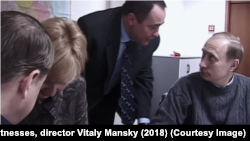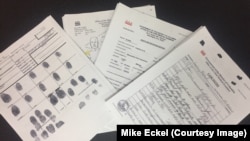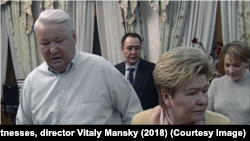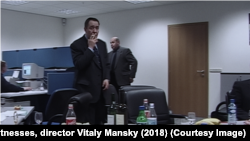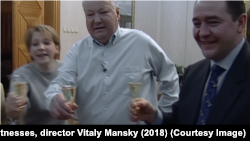WASHINGTON -- Mikhail Lesin, the former Russian press minister who turned up dead in a Washington hotel room in 2015, sustained a fracture to a neck bone just below the jaw line "at or near the time" of his death, according to documents released by the city's medical examiner that provide new details about his final days.
The finding does not provide clear-cut evidence of foul play in Lesin's death; another statement in the documents suggests the bone could have been damaged "after death" -- possibly during the autopsy.
That detail, however, and others contained in the 149-page file released exclusively to RFE/RL offer the most precise scientific description to date about Lesin's death, which officials ruled accidental and said was caused by blunt-force injuries amid excessive alcohol consumption.
Once a powerful media adviser to President Vladimir Putin, Lesin fell out of favor with the Kremlin elite sometime around 2012 and had lowered his public profile before he was discovered dead in the Dupont Circle Hotel, located a few blocks from the White House, on November 5, 2015.
The files were released by the Office of the Chief Medical Examiner in response to a Freedom of Information Act lawsuit, filed nearly two years ago by RFE/RL. Washington Judge Hiram Puig-Lugo last month ordered the city to turn over the files.
Among the new details revealed by the documents:
• Lesin's hyoid -- a bone located about midway between the larynx and the jaw bone -- was completely fractured;
• The FBI considered possibly taking over the case in early 2016. It wasn't clear whether the agency formally did so, though earlier files released by the agency show its agents were involved in questioning witnesses and examining video recordings from hotel cameras;
• Lesin's son, Anton, who lives in Beverly Hills, California, told investigators he did not know why his father was in the U.S. capital, and also reported that Lesin regularly had serious bouts of drinking while on business trips;
• The day after the Office of the Chief Medical Examiner released an initial report, one of its officials was summoned to appear before a criminal grand jury looking into Lesin's death;
• In a report filed the day of Lesin's death, a forensic investigator with the Office of the Chief Medical Examiner wrote that a detective had called and said a "friend" of the former Russian official had contacted him and "inquired about the decedent's location."
Despite the official conclusion that his death was "accidental," Lesin's links with Russia's ruling elite, the bizarre circumstances of his demise, and a string of strange deaths of Russians across the globe have fueled persistent speculation that he may have been killed.
Blunt-Force Trauma
On March 10, 2016, four months after Lesin's death, an initial report by the medical examiner's office declared Lesin died of blunt-force trauma to the head, neck, torso, upper and lower extremities, but said the manner of death was "undetermined."
The day after that announcement, according to the newly obtained files, an official from the medical examiner's office was subpoenaed to appear before a criminal grand jury investigating Lesin's death.
A final report, released in October 2016 by the U.S. Attorney's Office for Washington and Metropolitan Police Department, called his death accidental, caused or contributed to by blunt-force injuries to the head, neck, torso, and upper and lower extremities "which were induced by falls." Acute ethanol intoxication was cited as a factor.
The autopsy records obtained by RFE/RL show the extent of the cuts and bruising over his head, neck, upper torso, and lower torso, but do not say how the injuries occurred.
In a supplemental report from the Office of the Chief Medical Examiner dated April 1, 2016, an official recounted a conversation with an unidentified individual who had called to ask questions about the forensic anthropology report -- focusing on skeletal analysis -- in the Lesin case.
The caller, whose name and title was redacted in the document, asked "if the injury could have occurred with a fall," the official wrote.
"I explained that the position of the hyoid is protected by the mandible and that fractures are commonly associated with hanging or manual strangulation. I also said that I could not exclude a significant fall as a cause for the fracture, but I would expect soft-tissue injury to be associated with the impact," the official, whose name was also redacted, wrote.
The official also explained that an "autopsy artifact" -- or a change introduced into a corpse that can lead to forensic misinterpretation -- "must be considered as a possible cause of the fracture," according to the report.
The autopsy record said the fracture in the hyoid bone was a "complete transverse fracture." It also said that cartilage from the nearby thyroid was "atraumatic."
"The fracture margins are sharp and there is no gross evidence of healing indicating the trauma occurred at or near the time of death," it said.
According to a 2015 article published by the National Institute for Health, "fractures of hyoid bone resulting from trauma other than strangulation are very rare; hyoid bone fracture associated with panfacial trauma are even rarer."
Room And Board
The medical examiner's official report released in October 2016 was met with deep suspicion by business acquaintances and others familiar with the once-powerful, wealthy Kremlin insider who was instrumental in Russia's crackdown on independent TV and in the creation of the international broadcaster RT.
One person who had direct access to the hotel room where Lesin was found told RFE/RL in 2016 that it was physically impossible for him to have died alone in the room. Photographs released by police showed bottles of beer and liquor, stacks of dollar bills, and crumpled clothing on the floor. Associates of Lesin have argued that the Dupont Circle Hotel did not match his known tastes for expensive goods and lodging.
Prior to the Dupont Circle Hotel, Lesin had spent time at the more upscale Four Seasons Hotel in another part of Washington. According to the D.C. police report, officials at the Four Seasons had called the U.S. Secret Service on November 3 when Lesin appeared to be heavily intoxicated, and the Secret Service advised that a guard be posted at his door to prevent him from leaving. He checked into the Dupont Circle Hotel a day later.
According to the records, the Secret Service was already in the hotel, working to guard an unnamed official staying there.
Lesin drank most of the alcohol in the hotel room minibar, according to the new files, and on at least one occasion, was found wandering the hallway wearing only his underpants and a shirt.
A 'Friend' Was Looking For Lesin
In the newly released files, one document dated November 5, 2015, shows a forensic investigator with the Office of the Chief Medical Examiner who wrote that a detective had called and said a "friend" of Lesin had called him and "inquired about the decedent's location."
"Caller advised the decedent was last known alive Tuesday [November 3, 2015] in the afternoon leaving the Four Seasons hotel," the forensic investigator wrote.
There is no indication who the friend was.
Russia Today
Much of Lesin's vast wealth came from a private company he set up in the 1990s to sell television advertising on Russia's exploding TV-advertising market. That company, called Video International (VI), was later acquired by Yury Kovalchuk, the main shareholder of Bank Rossia, which has been closely linked to the Kremlin.
Lesin played a major role in the 1996 election campaign of Boris Yeltsin, and served as his main spokesman in the latter part of Yeltsin's tenure, including during Yeltsin's abrupt decision to resign, announced on December 31, 1999, and the appointment of Putin to be his successor.
As Putin's press minister in the early 2000s, Lesin was instrumental in bringing the country's national TV channels under Kremlin control, primarily NTV, a channel known at the time for its hard-hitting journalism. He went on to set up Russia Today, the global Kremlin mouthpiece known today as RT.
He lost favor with the Kremlin for unknown reasons sometime between 2012 and 2014, and he largely fell out of the public eye.
In 2014, a year before his death, Lesin had drawn the attention of the U.S. Senate, where one lawmaker had called on the FBI to investigate him for possible money laundering.
Lesin owned mansions in Beverly Hills, California, where his children and estranged wife live, and owned a yacht valued at $40 million. Months before his death, Russian media alleged that he was engaged to a Russian model much younger than him, and that she was pregnant with their child.
RFE/RL has been unable to confirm the whereabouts of the woman, identified as Viktoria Rakhimbayeva.
Lesin was not known to be a regular visitor to Washington. But shortly after his death, it emerged that one of his reasons for being in the U.S. capital was to attend a scheduled gala fundraiser at the Wilson Center's Kennan Institute on November 3, two days before his body was found.
One of the philanthropists being honored that night was the influential Russian banker Pyotr Aven. Lesin never attended the event.
Aven also attended a private event at the Atlantic Council, another Washington think tank, on November 4. According to a person with knowledge of that event, Lesin had sought to attend as well, but the organizers declined to include him.
When law enforcement agents interviewed Lesin's son, Anton, sometime during the investigation, he said he did not know why his father had traveled to Washington, D.C., according to the newly released files.
One person in contact with federal law enforcement officials told RFE/RL that Lesin had been in contact with the Justice Department in the months leading up to his death. In March 2018, the website BuzzFeed quoted unnamed sources as saying that former British intelligence officer Christopher Steele had given the FBI a report stating that Lesin was bludgeoned to death by enforcers working for an oligarch close to Putin. The identity of the oligarch was not revealed in the BuzzFeed report.
Steele later became famous because of a series of memos detailing President Donald Trump's alleged connections to Russia. Known as the Steele Dossier, the memos were circulated among Washington reporters in late 2016, and published in full by BuzzFeed in January 2017.
In their December 2017 report, D.C. police said that Lesin had been drinking heavily in the days prior to his death. A month later, the FBI released a 56-page file on its investigation, including the work by forensic experts into the closed-circuit video footage of the Dupont Circle Hotel.
The FBI files also included 29 pages from a report by the city medical examiner's office that were the basis of the official reason given by the city for his death. However, the pages were redacted almost entirely.
Russian officials have said little publicly about Lesin's death, aside from indicating early on that they expected U.S. law enforcement to provide full details.
Since his death, some of Lesin's assets have been gradually sold off. His yacht was sold in Florida in 2016.
In 2017, his two Beverly Hills mansions were listed for sale, at $23 million and $29 million. It isn't immediately clear if the homes have been sold yet.





